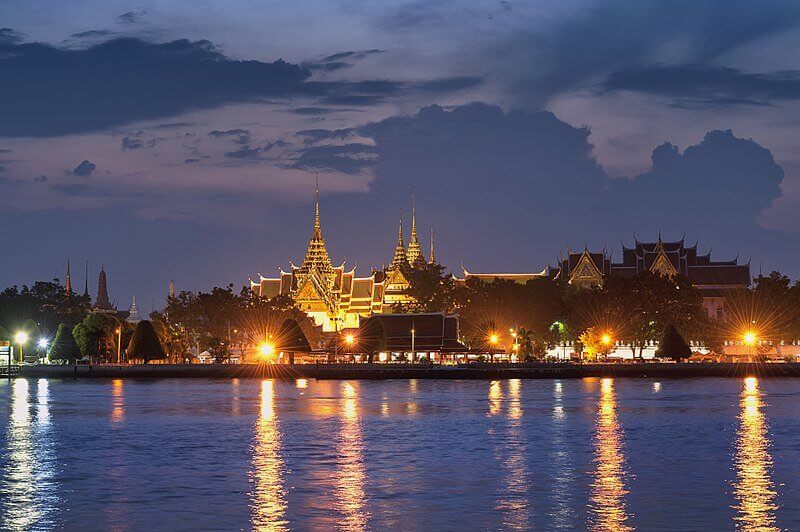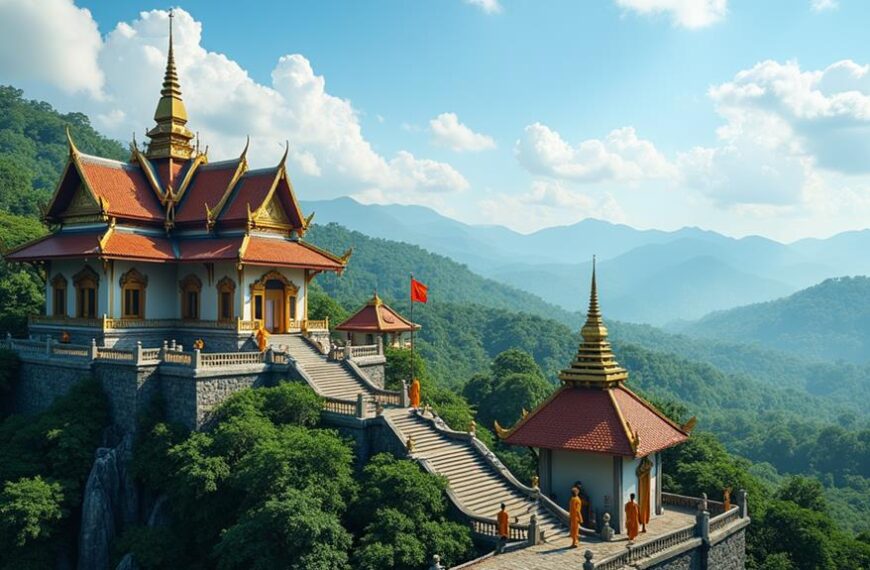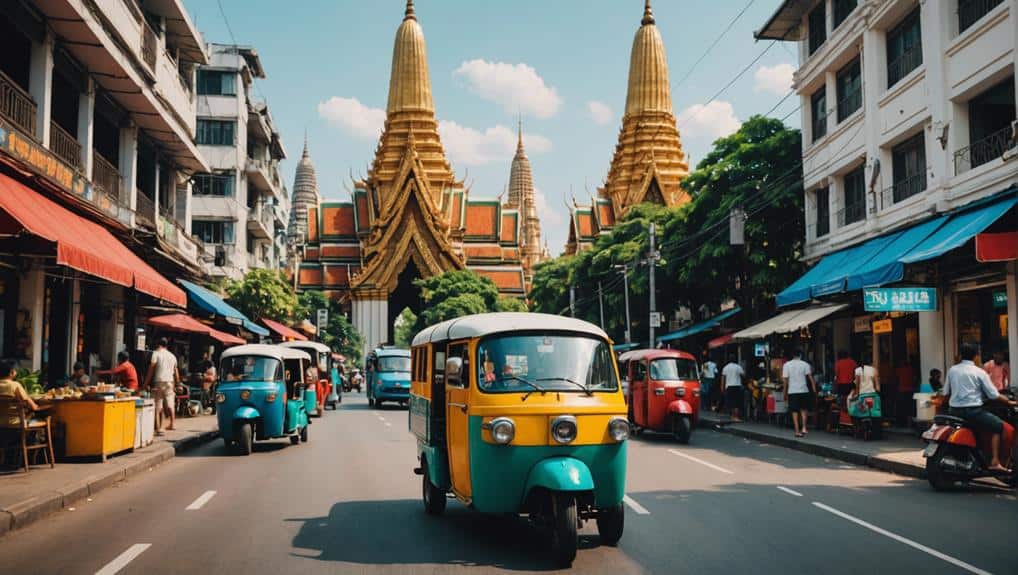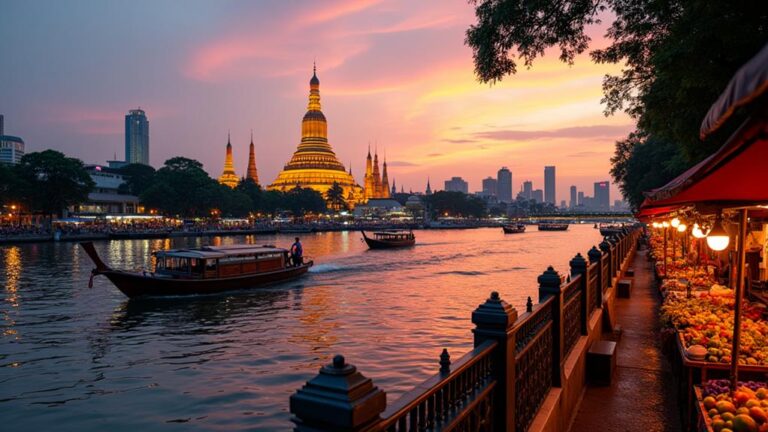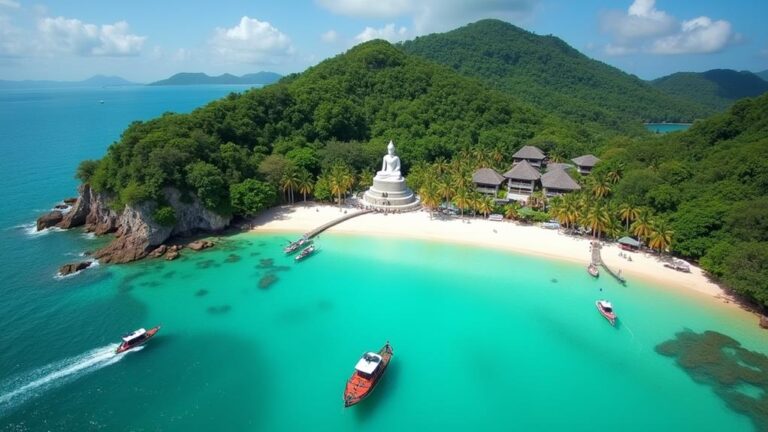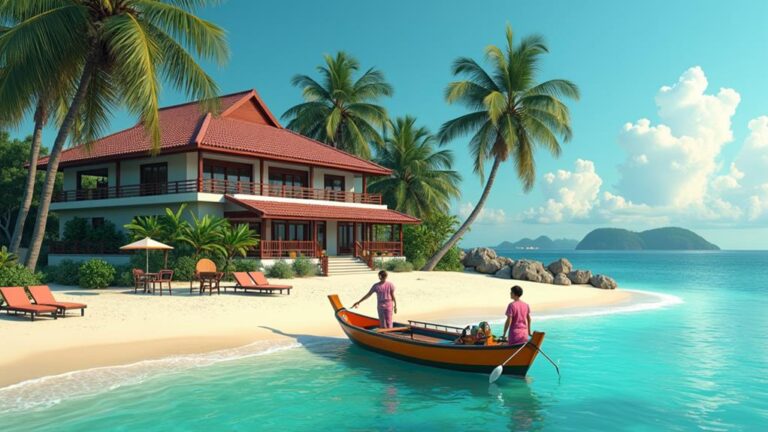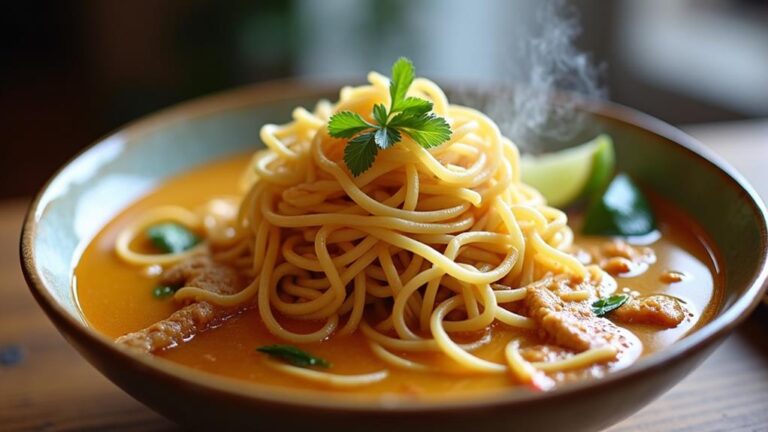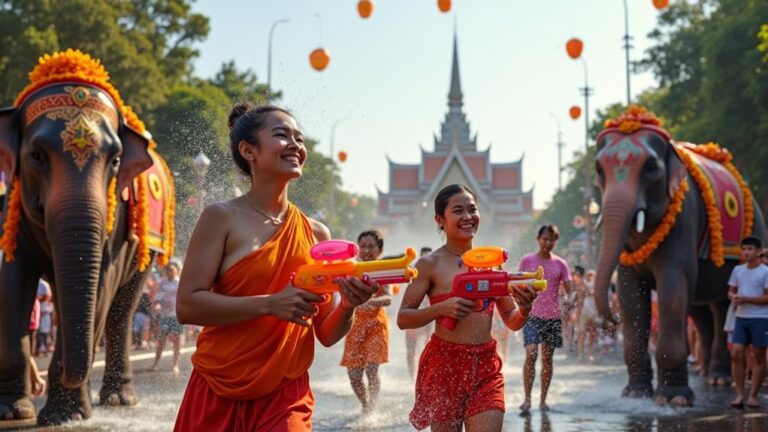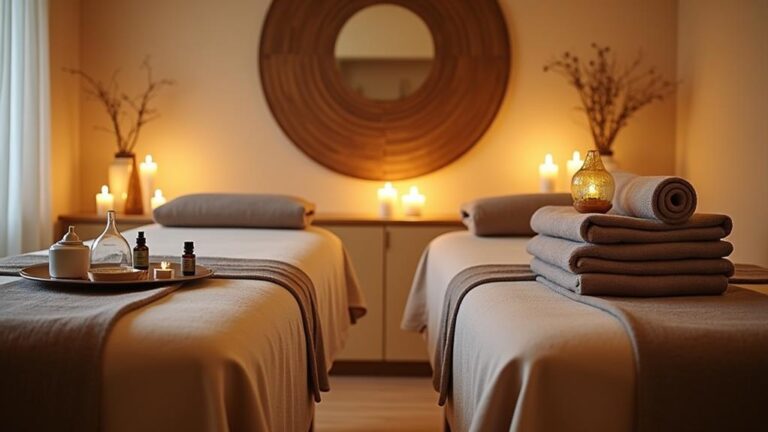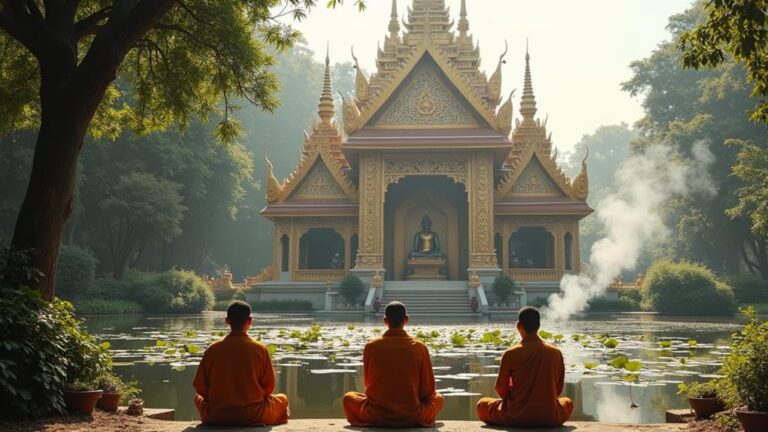As you walk into the Grand Palace in Bangkok, you’re surrounded by Thailand’s rich history and culture.
This amazing place has been important to Thai history since 1782. It shows a mix of traditional Thai, Ayutthaya, and European styles of architecture. Inside the palace is the famous Emerald Buddha, a highly respected symbol of Thai culture. Every year, millions of people visit the Grand Palace, making it Bangkok’s top tourist spot. The palace is full of colorful murals and vibrant colors, telling a story at every turn. Get ready to learn about Thailand’s royal history and discover why the Grand Palace is an unforgettable experience.
The Grand Palace is a special place because of its blend of different architectural styles. You can see traditional Thai styles alongside Ayutthaya and European influences. This mix of styles makes the palace unique and interesting. The palace is also home to the Emerald Buddha, a highly respected symbol of Thai culture. The Buddha is a symbol of good fortune and prosperity, and many people come to visit it every year.
The Grand Palace is a popular tourist spot, with millions of visitors every year. People come from all over the world to see the palace’s beautiful murals, colorful buildings, and vibrant decorations. The palace is a great place to learn about Thailand’s history and culture. Every aspect of the palace tells a story, from the intricate murals to the vibrant colors. The Grand Palace is an unforgettable experience that will stay with you forever.
Table of Contents
Key Takeaways
• The Grand Palace is steeped in rich history, having been the official residence of Thai kings from 1782 to 1925 and still used today by King Rama X.
• The palace is an architectural marvel, blending traditional Thai, Ayutthaya, and European styles with intricate details, vibrant colors, and symbolic elements.
• It is home to the revered Emerald Buddha, a highly revered jade statue that is worshipped by millions and is a major tourist attraction.
• The palace showcases Thailand’s cultural heritage, combining Hindu stories, Buddhist symbols, and Thai customs in its design, architecture, and art.
• The Grand Palace is a popular tourist destination, attracting millions of visitors annually with its stunning architecture, historical significance, and cultural richness.
Rich History and Cultural Significance
The Grand Palace in Bangkok is a very special place. It has been an important part of Thai history for over two centuries, since 1782.
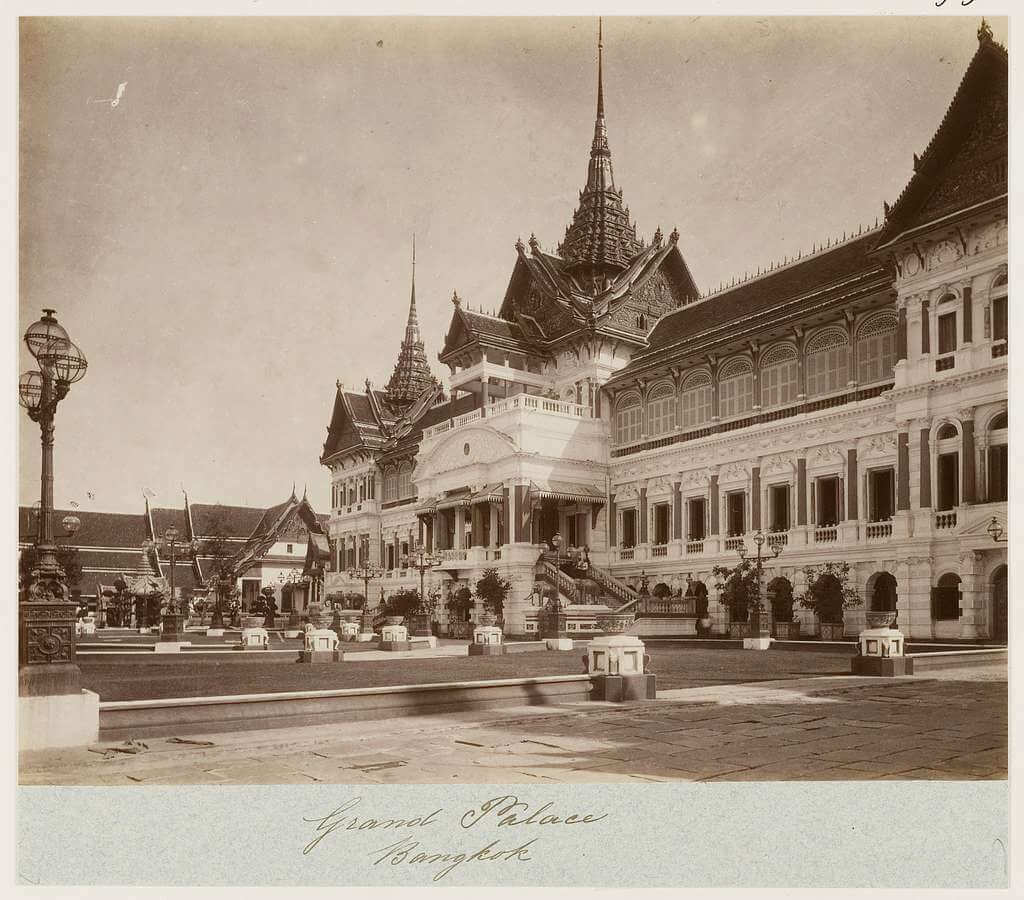
King Rama I built the palace after the old capital city of Ayutthaya was destroyed in 1767. For
a long time, the palace was the home of the kings of Thailand until 1925. Even today, the current king, King Rama X, still uses the palace.
The palace is important to Thai people because it shows how Hindu stories and Buddhist beliefs are connected. You can see this in the beautiful Ramakien murals on the walls.
As you walk through the palace, you’ll see how intricately it was designed and built. The palace has been fascinating visitors for centuries. It’s more than just a royal home – it’s a symbol of Thai heritage and culture.
Because of its importance, millions of people visit the Grand Palace every year, making it the most popular tourist attraction in Bangkok.
Architecture and Design Marvel
The Grand Palace is a stunning example of architecture and design.
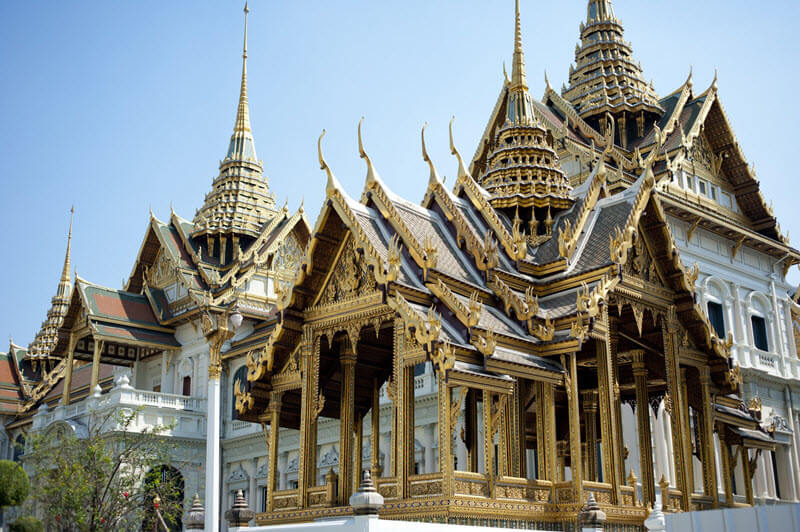
This magnificent building is a perfect blend of traditional Thai, Ayutthaya, and European styles. As you explore the palace, you’ll notice intricate details, vibrant colors, and symbolic elements that reflect Thai culture and history.
The palace is designed to impress, with multiple buildings, halls, pavilions, and courtyards, each serving specific ceremonial or administrative purposes.
Phra Thinang Dusit Maha Prasat, a ceremonial hall, symbolizes royal patronage. You’ll also see traditional Thai architecture, characterized by intricate carvings, curved roofs, and ornate details.
The palace also features European styles, with neoclassical influences, symmetrical facades, and grand entrances.
Everywhere you look, you’ll see ornate details, with vibrant colors, gilded decorations, and symbolic motifs.
The Grand Palace is a top tourist destination in Bangkok, attracting visitors from around the world with its cultural significance and historical importance. As you wander through the palace, you’ll be amazed by the seamless blend of traditional and European styles, making it a must-visit destination in Thailand.
Home to the Emerald Buddha
The Temple of the Emerald Buddha is a very special place inside the Grand Palace. It’s where you can find a very old and important statue called the Emerald Buddha. This statue is made of a single piece of jade and is decorated with golden clothes. For centuries, people have come to visit and worship this statue because it’s very special to them.
When you walk into the temple, you’ll be amazed by the Emerald Buddha. You’ll notice all the tiny details that make it so beautiful. The statue has been around since 1434, and it was first found in Chiang Rai. Later, it was moved to the Grand Palace, where it’s been ever since.
Today, millions of people visit the Temple of the Emerald Buddha every year. When you see the statue, you’ll understand why it’s so important to the people of Thailand.
Blend of Traditions and Legends
The Grand Palace is a truly magical place. Its beauty goes beyond its stunning architecture and ornate decorations. The real magic lies in how it combines traditions and legends from different cultures. You’ll see ancient Hindu stories, Buddhist symbols, and Thai customs all coming together in perfect harmony.
What makes the Grand Palace so unforgettable is the way it blends these different cultural elements.
Intricate storytelling is one reason. The palace’s Ramakien murals depict legendary tales that add to its fame and cultural significance.
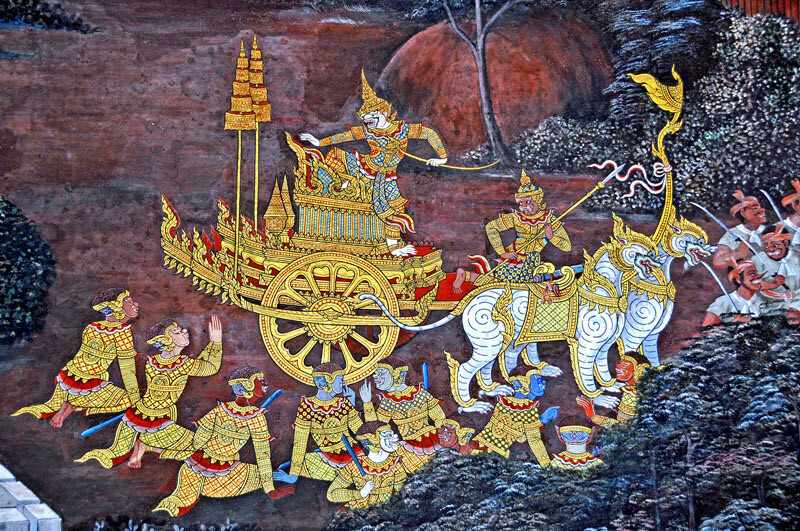
The palace’s design is also a unique blend of syncretic design, combining animism, Hinduism, and Buddhism in a way that creates a one-of-a-kind cultural experience.
Lastly, the palace’s vibrant cultural heritage is on full display, showcasing its rich cultural history and preservation through its religious and mythological representations.
As you walk through the palace, you’ll be surrounded by a world where Thai traditions, Hindu stories, and Buddhist symbols come together in a dazzling display of cultural fusion. The Grand Palace’s unique blend of cultural elements creates an experience that will leave you in awe.
Royal Residence and Ceremonial Halls
As you walk through the Grand Palace, you’ll come across the Royal Residence and Ceremonial Halls. For centuries, these halls have been home to Thai kings and queens. You’ll be amazed by the stunning architecture and rich history of these halls, which have hosted countless royal events and ceremonies.
Every corner of this palace complex is filled with history and tradition. From the grand Royal Throne Halls to the sacred rituals performed in the temple areas, you’ll discover the significance of these halls in Thai royal history.
Royal Throne Halls
The Royal Throne Halls are a majestic part of the Grand Palace. This is where Thai monarchs have lived and important ceremonies have taken place for a long time.
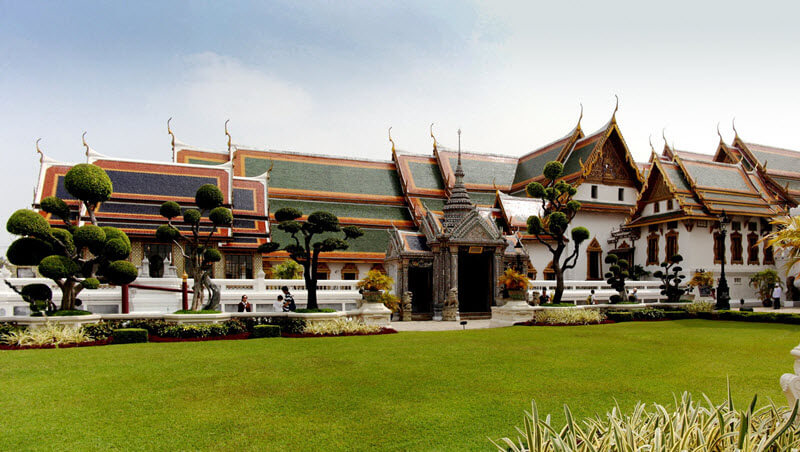
You are about to enter a very special place that’s important to Thailand’s cultural heritage. The Royal Throne Halls are made up of the Amarindra Vinichai Throne Hall and the Boromabiman Hall. These halls are where the Thai monarchs live and where important ceremonies and state functions happen.
The Throne Halls are important because they’ve seen many historic events like coronations and royal announcements that have shaped the country’s history. The halls are also very beautiful with intricate details and symbolic elements that show Thailand’s rich cultural heritage.
The Boromabiman Hall has been used for a long time to receive important guests, including visiting dignitaries and Buddhist monks.
As you explore the Throne Room, you’ll see how grand it is. This is where the Kings of Thailand have met with their people and held important ceremonies. Get ready to be amazed by the beauty of the Royal Throne Halls!
Ceremonial Rituals
You enter the magnificent Grand Palace, where vibrant Thai traditions come alive in the majestic ceremonial halls. These halls have been the heart of the monarchy’s rich heritage, hosting numerous state events and regal ceremonies since 1782.
The palace has witnessed many grand events, showcasing the country’s rich cultural heritage. Let’s take a peek into the grandeur of these ceremonial halls.
The Throne Room is where royal coronations take place, hosting royal functions and state events.
The historic Boromabiman Hall has seen many traditional ceremonies, including royal weddings and state visits.
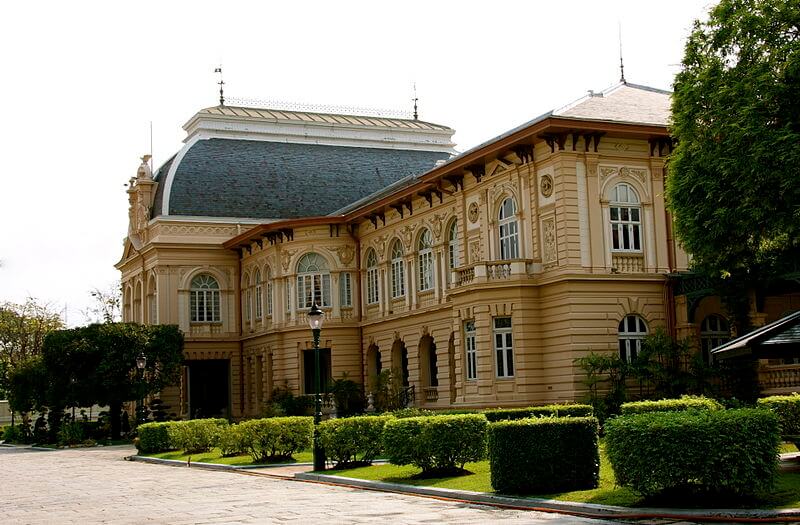
The grand Chakri Maha Prasat Hall is where dignitaries and state guests are received.
The Dusit Maha Prasat Hall is where royal ceremonies and events take place, while the Phaisan Thaksin Hall is where foreign dignitaries and state officials are received.
As you explore the palace, you’ll discover the significance of these historic halls, which have played a crucial role in the monarchy’s heritage.
Sacred Temple Areas
The sacred temple areas of the Grand Palace are truly special. The Temple of the Emerald Buddha is a powerful symbol of Thailand’s rich cultural heritage. This temple is part of the Grand Palace, where you’ll find the Royal Residences, including the Phra Maha Monthien Buildings, Phra Maha Prasat Buildings, and Chakri Maha Prasat Buildings. These buildings have been home to monarchs of the Chakri dynasty since King Rama I.
The temple areas will leave you in awe for three reasons.
Majestic Architecture is one reason. The Emerald Temple is a stunning example of Thai architecture, with its glittering green tiles.
Another reason is Spiritual Significance. As a Buddhist temple, it’s a sacred place of worship where you can experience the tranquility and serenity of Buddhist rituals.
Finally, the temple areas have Historical Importance. They’ve hosted significant events, including royal ceremonies and coronations, making them an integral part of Thai history and culture.
As you explore the sacred temple areas, you’ll be immersed in the rich cultural heritage and historical significance of Thailand.
Sacred Spots and Symbolic Structures
As you enter the Grand Palace, you’re surrounded by sacred spots and symbolic structures that showcase Thailand’s rich cultural heritage. The Temple of the Emerald Buddha is a must-visit, housing the revered Emerald Buddha, a sacred symbol of Thai culture.
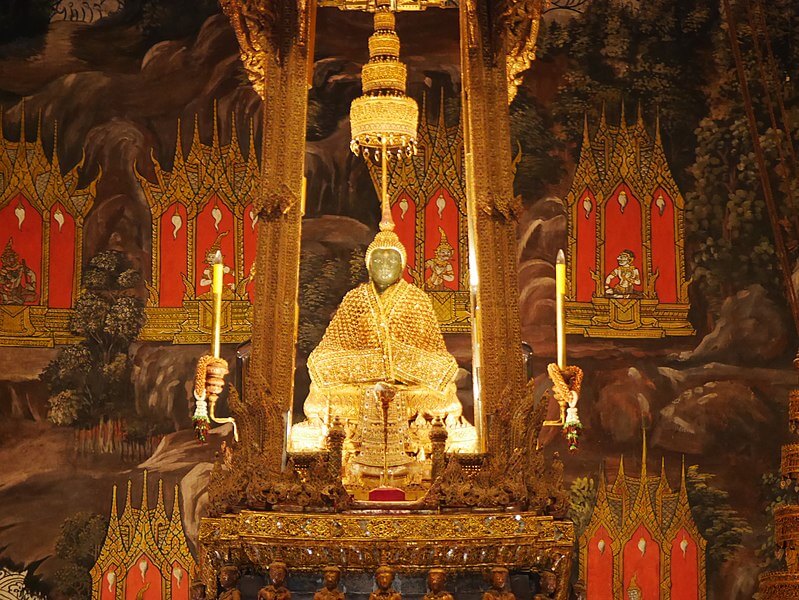
The Phra Si Rattana Chedi is a stunning example of symbolic architecture, blending Hindu and Buddhist influences in Thai architecture.
When you explore the Grand Palace, you’ll notice the intricate Ramakien murals that adorn the walls of Wat Phra Kaew. These murals depict the eternal battle between good and evil in Thai mythology.
The seven gates guarded by Yakshas, mythological creatures, add to the rich cultural heritage of the palace. The blend of Hindu and Buddhist influences is evident in the architecture and art, making the Grand Palace a true marvel of Thai culture.
Intricate Details and Artwork
As you walk through the Grand Palace, you’ll be amazed by all the intricate details and beautiful artwork.

The golden Buddha images sparkle in the light, and the colorful temple murals tell ancient stories. Every single element shows off the country’s rich cultural heritage.
You’ll be impressed by the delicate stucco work that adds extra beauty to the already stunning architecture. The artwork and details in the Grand Palace are truly breathtaking.
Golden Buddha Images
As you step into the Grand Palace, you’re immediately surrounded by stunning golden Buddha images that adorn the walls and corridors.
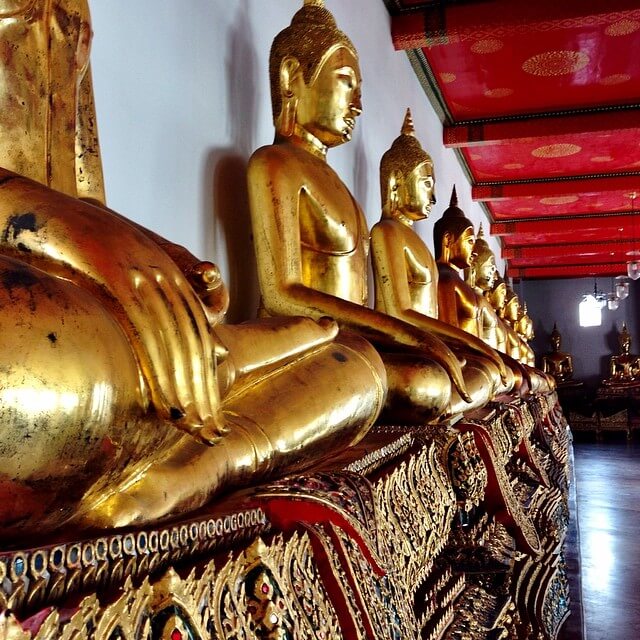
These intricate artworks weave a rich tapestry of Thai cultural and religious heritage, leaving you in awe.
The golden Buddha images at the Grand Palace are truly mesmerizing. Intricate designs cover every aspect of these images, showcasing the rich cultural and religious heritage of Thailand. The level of detail is breathtaking, conveying the country’s reverence for Buddhism and its cultural heritage.
The craftsmanship that has gone into creating these images is a tribute to Thailand’s traditional artistry. Every aspect of the images is meticulously crafted, demonstrating the country’s skill and artistry. The golden Buddha images serve as a powerful symbol of Thailand’s cultural and religious identity, evoking a sense of reverence and respect for the country’s rich heritage.
As you explore the Grand Palace, the golden Buddha images constantly remind you of the country’s deep cultural and religious roots. The incredible craftsmanship and artistry that has gone into creating these stunning works of art leave a lasting impression.
Elaborate Temple Murals
The Grand Palace is home to some of the most beautiful and intricate temple murals you’ll ever see.
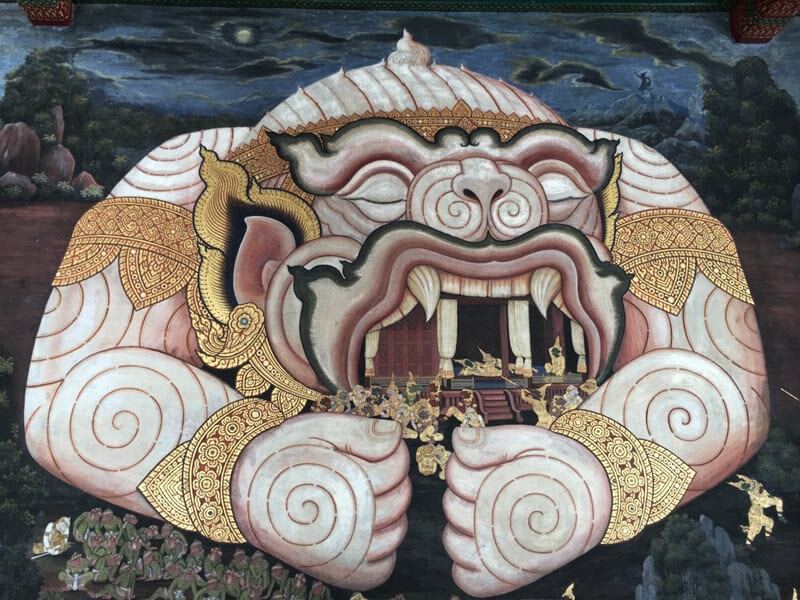
One of the most impressive is the Ramakien mural at Wat Phra Kaew. These murals take you on a journey through Thai myths and legends, telling stories of good vs. evil in a world of vibrant colors and symbolism.
Every brushstroke of these masterpieces tells a story that’s both magical and educational. You can’t help but be amazed by the level of skill and craftsmanship that went into creating these artworks. The Ramakien mural is especially impressive, giving you a unique peek into Thai culture.
The paintwork is so impressive that it adds to the cultural significance of the Grand Palace, making it a must-see for anyone interested in Thai history and culture.
Vibrant colors and intricate details make these murals a true treasure of Thai heritage.
Delicate Stucco Work
The Grand Palace’s delicate stucco work is a testament to the skill of Thai artisans.
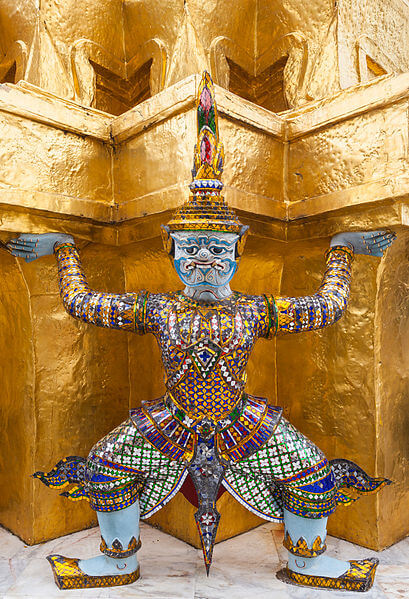
As you walk through the palace, you’re surrounded by intricate patterns, floral motifs, and mythical creatures that adorn the exterior walls and pillars. These designs showcase traditional Thai craftsmanship and artistic heritage.
The stucco decorations are a result of the artisans’ meticulous work, demonstrating their mastery of intricate details and artwork. Every curve and line is carefully crafted to perfection, leaving visitors in awe.
Three things make the Grand Palace’s stucco work truly remarkable.
- Intricate patterns will mesmerize you, with every detail meticulously crafted.
- Mythical creatures add a touch of whimsy and fantasy to the grand architecture.
- Floral motifs bring elegance and sophistication to the palace.
As you explore the palace complex, the delicate stucco work transports you to a world of beauty and wonder. You’ll see the best of traditional Thai craftsmanship and artistic heritage on full display.
Is the Grand Palace Worth visiting?
The Grand Palace in Thailand is a top tourist spot that attracts millions of visitors each year.

This magnificent palace complex offers an unforgettable experience, taking you back in time to explore the lives of Thai monarchs and court members who once lived within its walls.
The Grand Palace is a must-visit site in Bangkok because of its rich cultural heritage. The palace showcases the best of Thai craftsmanship and artistry through its stunning architectural details. Historical significance is another reason to visit, as the palace has a history dating back to the 18th century, providing a glimpse into Thailand’s rich past and the lives of its monarchs.
What makes the Grand Palace so fascinating is the diverse range of attractions it offers. From shrines to courtyards, there’s something for everyone to enjoy. As you explore the palace complex, you’ll be amazed by the grandeur of Thai royalty and the rich cultural heritage that permeates every aspect of this famous tourist destination.
Every aspect of the palace’s design reflects Thailand’s rich cultural heritage. The palace tells the story of the country’s history, traditions, and values. As you walk through the palace, you’ll be struck by its sheer scale and beauty.
This unforgettable experience will stay with you long after you leave the Grand Palace. Find more information and also book the ticket here
FAQs
Is the Grand Palace made of gold?
While the Grand Palace features gold accents and decorations, it is not made entirely of gold. However, gold leaf is used extensively in its ornamentation.
What are the rules for the Grand Palace Thailand?
Visitors are expected to dress modestly, behave respectfully, and follow the designated pathways. Photography may be restricted in certain areas, and visitors should refrain from touching or climbing on any structures.
Is there a dress code for the Grand Palace?
Yes, there is a dress code. Visitors should dress modestly, covering their shoulders, arms, and knees. Sleeveless shirts, shorts, and skirts above the knee are not allowed. Scarves or shawls may be provided for those not meeting the dress code.
Can I wear sandals?
Sandals are generally acceptable footwear for visiting the Grand Palace, but it’s essential to ensure they are comfortable for walking, as the grounds can be extensive.
